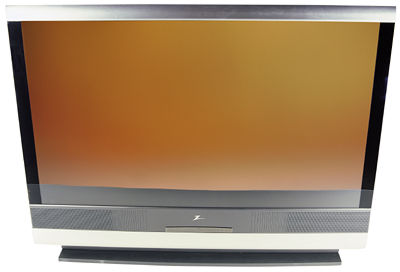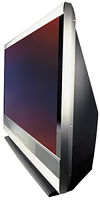Zenith D60WLCD HD-ready rear-projection LCD television

The Zenith D60WLCD competes head on with Sony's 60-inch-diagonal Grand Wega LCD. The products are remarkably similar. However, the Sony's native resolution is 1366x768, while the Zenith's is 1280x720. The latest version of the Sony is also $500 more expensive. Both can display the rare 720-line progressive-scan HDTV shows in their native resolution while converting the far more common 1080-line interlaced fare to 720p.
The cabinet of the Zenith's 16:9 widescreen set is sleek and handsome: silver and gray, with vertical black stripes framing the screen. It's also impressively large—some visitors gasp when they see it the first time. The top of the cabinet is only 2 or 3 inches deep, too narrow to support a center-channel speaker. Below the screen is a panel housing two small speakers, which, using a special connection from your preamp-processor on the Zenith's rear panel, can be used as a center-channel speaker. The rear panel holds a nice array of inputs, including two component-video (though just one of those is wideband, for a DTV tuner or progressive-scan DVD player) and one RGB.
The D60WLCD comes with a variety of useful features, including full control of aspect ratio and five different ways of stretching or squeezing the image to reduce or eliminate vertical bars or letterboxing. I particularly liked the programmable remote control, which is fully backlit. (The Sony Grand Wega's is not.) Two NTSC tuners are included for picture-in-picture features that let you resize the frames. There's 3:2 pulldown detection and correction, as well as a top-of-the-line 3D comb filter for composite inputs.
 Like some Zenith products, the D60WLCD is made in Korea. Zenith, which has been making radios and TVs in the US for 80 years, has been a wholly owned subsidiary of LG Electronics, the Korean corporate giant, since 1999
Like some Zenith products, the D60WLCD is made in Korea. Zenith, which has been making radios and TVs in the US for 80 years, has been a wholly owned subsidiary of LG Electronics, the Korean corporate giant, since 1999
Performance
The D60WLCD is a well-designed and solid performer, within the limits of its technology. Like all LCDs, it took a minute or two to warm up. If you're not accustomed to this, it can be disconcerting to turn on an LCD and at first see only a dim, pallid screen. But when it finally reached full brightness, the colors of this very big screen snapped with bright, vivid detail.
As with all fixed-panel displays, the D60WLCD makes use of an onboard scaler to convert all standard-definition and 1080i inputs to its native 720p resolution. Until recently, many line doublers built into HD-ready televisions have been artifact-prone and did more harm than good. This one, however, performed quite well. Playing high-quality DVDs like the SuperBit version of The Fifth Element, I saw precious few artifacts (jagged lines or broken edges). The opening, temple scene can be a torture test for some line doublers: The desert sand comes alive with errors, and the treads on the plank leading to the temple break up. That happened with the doubler in Zenith's first-generation 60-inch plasma display (reviewed in January 2002), but not with this 60-inch LCD. The sand was clean, the board held together. The D60WLCD's scaler is a winner.
The Zenith's resolution was also impressive. Viewing casually, I got the impression that the sharpness was outstanding. And on frequency-sweep resolution tests, the D60WLCD was able to resolve every single line.
- Log in or register to post comments




































































